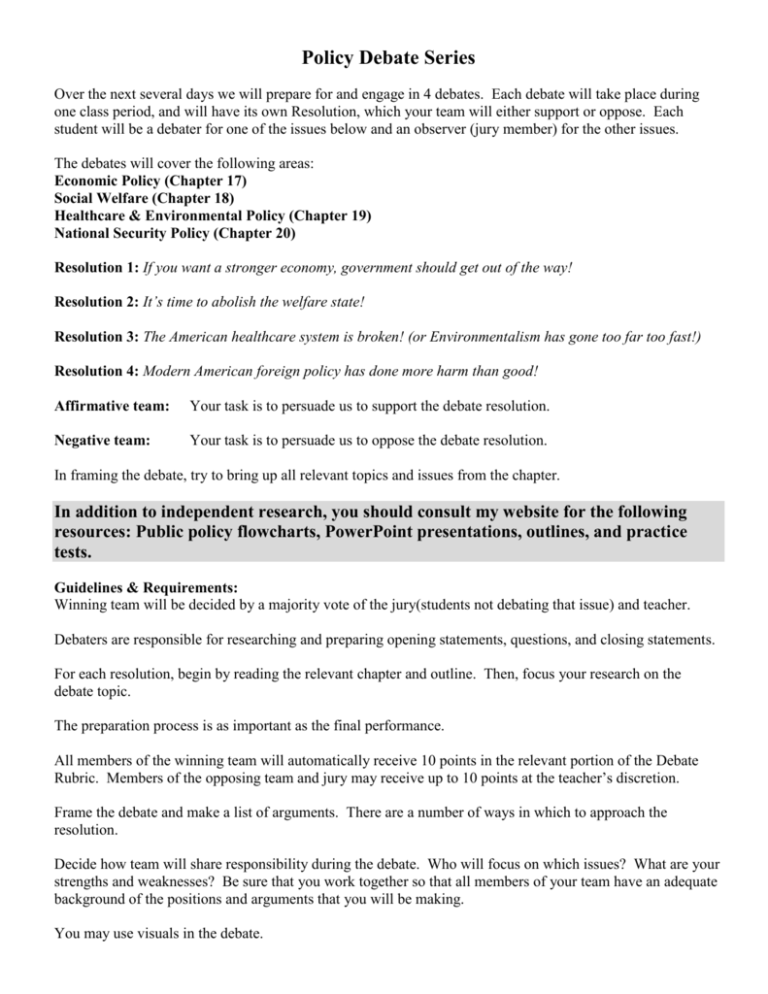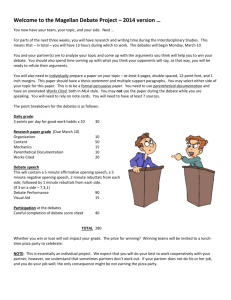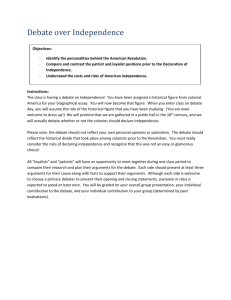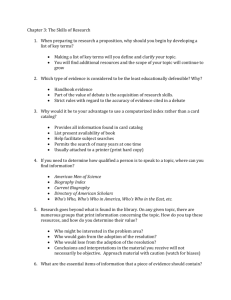Policy Debate Series - Livingston Public Schools
advertisement

Policy Debate Series Over the next several days we will prepare for and engage in 4 debates. Each debate will take place during one class period, and will have its own Resolution, which your team will either support or oppose. Each student will be a debater for one of the issues below and an observer (jury member) for the other issues. The debates will cover the following areas: Economic Policy (Chapter 17) Social Welfare (Chapter 18) Healthcare & Environmental Policy (Chapter 19) National Security Policy (Chapter 20) Resolution 1: If you want a stronger economy, government should get out of the way! Resolution 2: It’s time to abolish the welfare state! Resolution 3: The American healthcare system is broken! (or Environmentalism has gone too far too fast!) Resolution 4: Modern American foreign policy has done more harm than good! Affirmative team: Your task is to persuade us to support the debate resolution. Negative team: Your task is to persuade us to oppose the debate resolution. In framing the debate, try to bring up all relevant topics and issues from the chapter. In addition to independent research, you should consult my website for the following resources: Public policy flowcharts, PowerPoint presentations, outlines, and practice tests. Guidelines & Requirements: Winning team will be decided by a majority vote of the jury(students not debating that issue) and teacher. Debaters are responsible for researching and preparing opening statements, questions, and closing statements. For each resolution, begin by reading the relevant chapter and outline. Then, focus your research on the debate topic. The preparation process is as important as the final performance. All members of the winning team will automatically receive 10 points in the relevant portion of the Debate Rubric. Members of the opposing team and jury may receive up to 10 points at the teacher’s discretion. Frame the debate and make a list of arguments. There are a number of ways in which to approach the resolution. Decide how team will share responsibility during the debate. Who will focus on which issues? What are your strengths and weaknesses? Be sure that you work together so that all members of your team have an adequate background of the positions and arguments that you will be making. You may use visuals in the debate. DEBATE FORMAT 1. OPENING STATEMENTS 10 minutes There will be an opening statements made by your team. At least two members should speak. Opening statements should introduce the topic, frame the debate, state your team’s position and the arguments you will be making. - AT opens first 2. QUESTIONING (ROUND 1) 30 minutes During questioning, one side asks questions to advance its position and undermine its opponents’ position. These must be done in the form of questions, not statements. The other side answers the questions, but tries to do so in a way that it advances its position and undermines the other side. These must be done in the form of answers, not questions. NT questions AT for 15 minutes. All members of team may ask and answer questions. AT questions NT for 15 minutes. All members of team may ask and answer questions. 3. CLOSING STATEMENTS 10 minutes There will be a closing statement delivered by each team. This should wrap up your argument and persuasively demonstrate that your side has prevailed. NT closes last.







